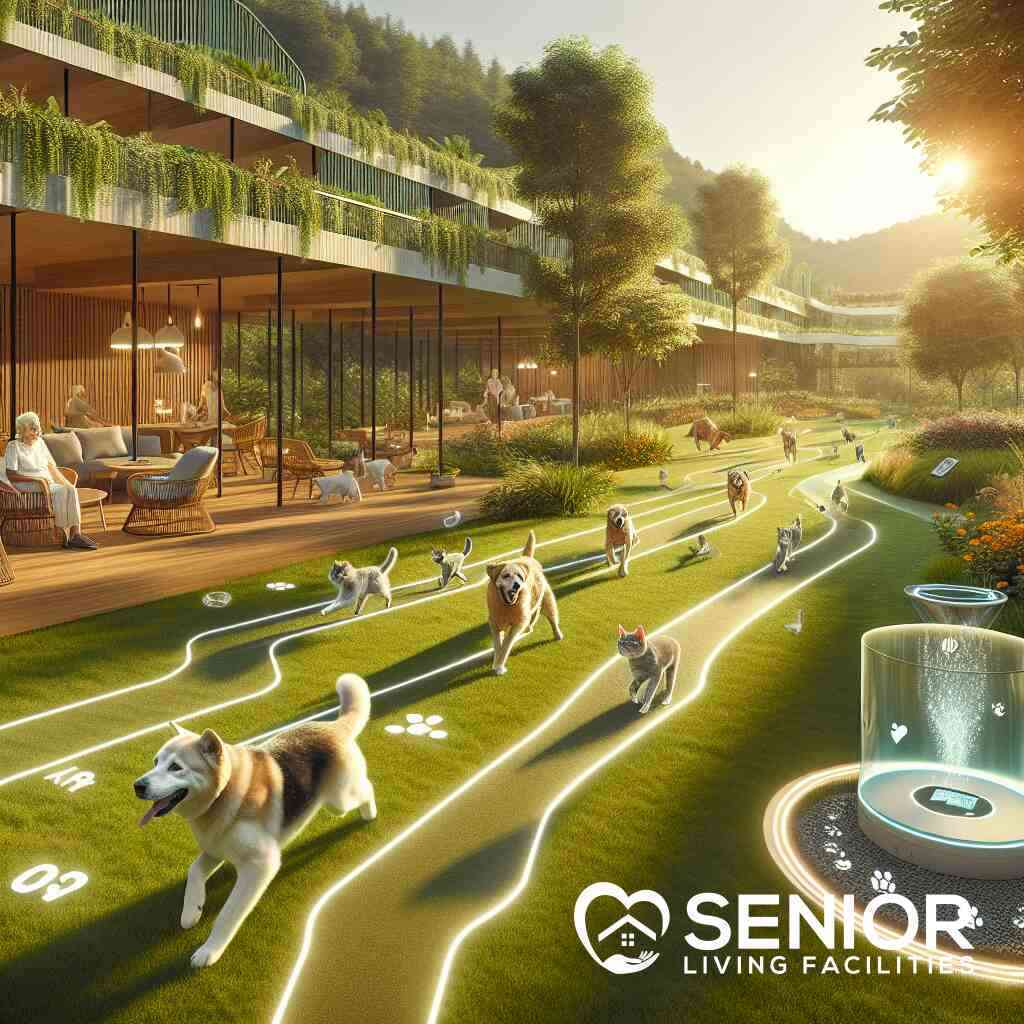
The Future of Pet-Friendly Senior Communities in 2025
May 6, 2025
Introduction: A New Era of Companionship
Understanding the Growing Demand for Pet-Friendly Senior Living
In recent years, the demand for pet-friendly senior communities has surged. This uptick reflects a deeper understanding of the holistic benefits pets offer in enhancing the lives of seniors. A growing number of Americans view pets not just as companions but as family members they can’t bear to part with. As the aging population seeks out senior living options, there is an increasing push for those facilities to embrace this bond. The shift signifies a transformation in how we perceive housing options for seniors, highlighting an essential component of emotional and cognitive wellness within these communities.
The Role of Pets in Enhancing Senior Well-being
Pets are vital for seniors, offering more than just companionship. They help reduce feelings of isolation and provide routine, which is crucial for maintaining emotional equilibrium. Studies underscore how interaction with animals can lower blood pressure, decrease depression, and improve heart health, a compelling testament to the therapeutic effects of pets. By weaving the presence of pets into the fabric of senior living, communities can significantly bolster emotional support and foster environments of happiness and well-being.
Setting the Stage for 2025: Trends and Predictions
Looking towards 2025, the integration of pets in senior living facilities is expected to become a standard rather than a rarity. With technological advancements and evolving societal attitudes, senior living facilities near you are poised to redefine the role of pets in daily activities and community-building.In the future, senior apartments will likely be allowed for pets with specially designed pet-friendly amenities. Such advancements promise to enhance not just individual lifestyles but the communal dynamics of these spaces, ushering in an era where pet companionship is seamlessly integrated into the core of senior care.
The Heartbeat of Senior Communities: Integrating Pets into Assisted Living
Designing Pet-Friendly Spaces: More Than Just Permissible
Creating a truly pet-friendly senior living facility requires more than simply allowing pets on the premises. It involves intuitive architectural design and thoughtful amenities that cater to both human and animal residents. Dedicated pet play areas, pet washing stations, and easily accessible open spaces are just a few elements transforming the landscape of senior housing. These enhancements are more than luxuries; they are vital components for facilitating the effortless integration of pets into daily life. This approach not only nurtures animal welfare but also promotes an enriched living environment where both seniors and their companions can thrive. At its core, these efforts aim to craft communities where the presence of pets is a valued aspect of daily routine and interaction.
Health and Happiness: How Pets Transform Senior Lives
The integration of pets into senior living environments has demonstrated substantial improvements in resident well-being. Pets are instrumental in decreasing stress levels and enhancing emotional stability among seniors. The companionship provided by animals can often lead to measurable improvements in mental health, reducing the incidence of depression and anxiety. Additionally, the presence of pets often introduces more physical activities into daily routines, promoting healthier lifestyles. This holistic improvement in both physical and emotional health contributes to a robust environment where seniors can truly flourish.
Navigating Pet Policies: Balancing Community Needs and Personal Freedoms
Developing comprehensive pet policies is crucial in maintaining harmony within pet-friendly senior communities. These policies must balance individual freedoms with the wider community’s needs. It’s essential to stipulate clear guidelines regarding pet sizes, types, and care requirements to ensure all residents feel comfortable. Regular health checks and certifications may also be mandated to promote community safety and satisfaction. By navigating these challenges with empathy and foresight, pet-friendly senior communities can ensure peace and cohabitation benefits all residents. With attention to these details, the integration of pets in senior living becomes not just feasible but a shining success.
Innovations in Pet-Friendly Senior Living: Bridging Technology and Care
Technology and Pets: Enhancing Care through Innovation
In the dynamic realm of senior living, technology plays a pivotal role in revolutionizing the care for both residents and their beloved pets. Senior living facilities are increasingly integrating smart technologies to ensure that they remain top senior living facilities in 2025. These advancements include automated feeding systems, interactive pet toys monitored via apps, and even AI-driven behavior analysis tools that help track pet health and happiness. Such technology not only alleviates daily care burdens but also enhances the quality of life for seniors by providing peace of mind that their furry friends are well-cared for. As the line between digital innovation and pet care continues to blur, these tools are laying the foundation for more sophisticated and automated solutions in the future.
Virtual Pet Therapy Programs: A Modern Solution
The advent of virtual pet therapy programs marks a significant milestone in the landscape of senior community wellness. These programs leverage digital platforms to bring the joys and therapeutic benefits of animal interactions to seniors who may not be able to have pets physically present. Through virtual interactions using augmented reality and interactive video conferencing with therapy animals, seniors can experience emotional upliftment and cognitive stimulation right from their communities. This not only broadens access to pet therapy in senior living areas but also highlights how these innovative programs become crucial pillars of emotional support. Harnessing the potential of these virtual innovations in senior living ensures comprehensive care, fostering a sense of vibrant connection even from a distance.
Smart Home Adaptations for Enhanced Pet Management
The rise of smart home technology in age-restricted community residences is simplifying pet management for seniors, providing tailor-made solutions for harmonious cohabitation. These adaptations include automated lighting for pet safety, voice-activated pet care reminders, and smart door systems allowing pets safe, controlled outdoor access. The versatility of these technologies addresses potential mobility issues faced by elderly pet owners, ensuring that both guests and residents can enjoy a secure environment. By embracing these technological advancements, senior living facilities can offer animal-friendly retirement options that cater to both human and pet needs. These tailored solutions promote peace of mind, letting seniors and their pets enjoy a comfortable, worry-free lifestyle.
The Emotional and Therapeutic Dimensions of Pet Companionship
Emotional Support Animals: New Guidelines and Benefits
The emergence of emotional support animals (ESAs) in senior living facilities is a noteworthy trend that is expected to expand by 2025. ESAs provide seniors with unparalleled emotional support, assisting in alleviating symptoms of anxiety and depression. Unlike service animals, ESAs don’t require specialized training, making them more accessible to seniors seeking companionship. Recent guidelines emphasize the importance of certifying these animals to heighten their efficacy in providing emotional relief. As the role of ESAs grows in senior living, understanding their benefits is crucial. They foster a sense of security and affection, elements vital for maintaining seniors’ overall wellness and mental health within assisted living plans.
Additionally, the shift towards recognizing ESAs within nursing homes and assisted living facilities marks a positive change in how emotional well-being is prioritized. With new regulations and guidelines, these communities can set standards ensuring that the presence of ESAs enhances the quality of life for residents. Such changes underscore the integration of ESAs as indispensable partners in supporting the emotional stability of elderly pet owners.
Pet Therapy as a Household Standard in Senior Living
As the therapeutic advantages of pet therapy in senior living gain broader acknowledgment, the practice is poised to become a regular feature in most senior communities by 2025. Pet therapy involves structured interactions with trained animals, aiming to boost emotional and physical wellness among seniors. It is already becoming standardized in many retirement communities and assisted living facilities, attesting to its profound impact on mental health.
The introduction of pet therapy as a regular activity not only aids in emotional healing but also fosters social engagement, as community members often participate in these sessions. This level of interaction provides a pleasant distraction and encourages healthier living patterns through increased physical activity. Senior facilities have observed that residents involved in pet therapy exhibit improved moods and a decrease in feelings of isolation, highlighting its significance in creating vibrant and supportive environments.
The implementation of such therapies supports cognitive wellness in senior living, contributing significantly to seniors’ ability to cultivate positive emotional states. As the popularity of pet therapy continues to rise, it is anticipated that it will be as common in senior living facilities as other daily activities, thereby ensuring a holistic approach to mental and emotional care.
Building Emotional Wellness Programs: Pets as Key Facilitators
Developing comprehensive emotional wellness programs that integrate pets as central elements is set to transform senior living communities. These initiatives focus on teaching seniors how to incorporate pets into their daily routines effectively, maximizing the ensuing health and happiness benefits. With the support of animals, these programs can cater to diverse emotional needs, assisting seniors in managing stress and maintaining cognitive health.
The strategic involvement of pets in wellness programs is not just about companionship but also aims to foster dynamic community interactions and promote assisted living environments where emotional support is readily accessible. Creating these programs necessitates collaboration between caretakers, health professionals, and legal teams to ensure they meet both emotional and regulatory requirements.
Incorporating pets into emotional wellness programming encourages a compassionate community culture and demonstrates a commitment to innovations in senior living. By recognizing the intrinsic value that animals bring to maintaining an emotionally nurturing environment, senior facilities can offer improved quality of life to residents. Consequently, as pet-driven emotional wellness programs flourish, they will spearhead a forward-thinking approach to senior care, uniquely positioning facilities to address and enhance resident satisfaction and health.
Creating the Ideal Pet Policy: Balancing Passion and Protocol
Developing Inclusive Pet Policies: A Guide for Management
Establishing inclusive pet policies in senior communities demands a nuanced approach. Management needs to consider the unique dynamics that pets introduce into senior living environments. These policies should address various aspects, from the types and sizes of pets allowed to environmental accommodations that ensure both pet and resident comfort. Successful management results from involved discussions with residents and their families, underscoring a genuine commitment to transparency and communication. Moreover, consideration should be given to residents without pets, ensuring shared community spaces maintain balance and respect for everyone’s preferences. By fostering an inclusive dialogue, senior living facilities can craft pet policies that resonate with all residents, enhancing communal harmony.
Ensuring Community Safety: Health Checks and Certifications
To uphold the safety and health of both residents and their animal companions, stringent health checks and certifications must be an integral part of pet-friendly policies. Regular veterinary visits and up-to-date vaccinations are often required to ensure that all pets in the community are healthy and pose no health risks to residents. Implementing such protocols reassures seniors and their families of a safe living environment, building trust between residents and the facility management. Additionally, these health standards contribute to the well-being of the pets themselves, promoting longevity and vitality. By prioritizing comprehensive health checks, senior living communities can safeguard public health while maintaining their commitment to pet-friendly environments. This process aligns with industry best practices and commits to ensuring peace of mind for all residents, their families, and staff members.
Fostering a Culture of Compassion: Staff Training and Awareness
Developing a compassionate, pet-friendly culture hinges on dedicated staff training and increased awareness. Staff members should receive detailed training on how best to support senior residents with pets, which includes understanding animal behavior and basic pet care skills. Equipping staff with these competencies facilitates smoother interactions between people and their animal companions, aiding in problem-solving and crisis management. Furthermore, awareness programs can highlight the emotional and physical benefits pets bring to senior living, reinforcing the community’s commitment to mental and emotional wellness. By cultivating a compassionate atmosphere, senior living facilities create an inviting environment where the presence of pets amplifies rather than complicates communal living. Such initiatives not only improve the quality of life for residents but also align with a broader understanding of senior living principles, which advocate for comprehensive and empathetic care.
Conclusion: Paving the Path Forward
Summarizing the Impact of Pets in Senior Living: A Reflection
In the landscape of senior living facilities, integrating pets has undeniably transformed these communities into hubs of warmth and companionship. The multifaceted benefits offered by pet-friendly environments go beyond mere companionship; they encompass holistic health improvements, with measurable boosts in physical and emotional wellness. These uplifting impacts affirm the growing trend in adopting pet-friendly policies across senior living facilities. In doing so, communities are not only enhancing the quality of life for seniors but are also refining their approach to cognitive wellness in senior living. As we reflect on the strides made thus far, it becomes clear that incorporating pets contributes significantly to creating inclusive, vibrant living spaces.
Preparing for Continual Growth and Improvement
To achieve sustained progress, senior living communities must remain committed to evolving with changing societal needs and expectations. As more residents seek accommodations that prioritize both personal and pet well-being, facilities will need to implement structures and policies that ensure stress-free integration of pets. This involves investing in animal-friendly retirement options and continually refining care models that offer superior living experiences. By fostering collaborative efforts among residents, families, and management, communities can effectively respond to feedback and encourage innovation. These steps are crucial in maintaining ongoing growth, ensuring that facilities not only keep pace with but also anticipate changes within senior living environments.
Imagining the Future: Pet-Friendly Senior Communities Beyond 2025
Looking beyond 2025, the potential for pet-friendly senior communities is boundless. Senior Living Facilities: Future Trends for 2025. Future senior living facilities will likely see an unprecedented intertwining of technology and care, transforming how seniors and their pets coexist. As communities embrace the impact of senior living facilities on health and well-being, the future landscape will witness innovations like AI-powered care solutions and immersive virtual pet interactions. Exploring the Role of Tech in Senior Living Innovation.These advancements will redefine the very essence of living, creating an ideal environment where pets and their senior companions can thrive together. The promise of this future holds a beacon of optimism and constantly pushes the envelope on what senior care can achieve. The Ultimate Guide to Senior Living for 2025
Frequently Asked Questions
Question: Do Hodoes Senior Living Facilities adapt to the growing trend of pet-friendly senior living communities?
Answer: Senior Living Facilities is dedicated to staying at the forefront of evolving trends in senior housing, including the increased demand for pet-friendly options. By offering a comprehensive platform that highlights pet-friendly assisted living and pet-friendly senior housing, we ensure seniors can find communities that warmly welcome their beloved pets. Pet-Friendly Senior Housing in 2025. Our listings are continuously updated to showcase communities with pet amenities like dedicated pet play areas and pet washing stations. Trusting Senior Living Facilities means having access to a curated selection of the best pet accommodations in senior facilities.
Question: In what ways does the blog title ‘The Future of Pet-Friendly Senior Communities in 2025’ reflect your services?
Answer: ‘The Future of Pet-Friendly Senior Communities in 2025’ embodies the innovative spirit and forward-thinking approach that Senior Living Facilities employs in providing senior care solutions. Our platform ensures that those seeking pet-friendly senior residences can find options that integrate pet care seamlessly into community living. The Ultimate Guide to SeniorCommunities.s From smart home adaptations for pet management to virtual pet therapy programs, we capture these forward-looking services within our listings, ensuring that seniors with pets find suitable long-term care facilities that align with emerging trends.
Question: How do Senior Living Facilities ensure community harmony in pet-friendly senior communities?
Answer: At Senior Living Facilities, we understand the importance of balancing community needs and personal freedoms when it comes to pets in senior living. Comprehensive pet policies are established in the communities we feature, focusing on guidelines that specify pet sizes, types, and care requirements. Additionally, regular health checks and certifications are required to ensure the well-being of all residents and their animal companions. Our commitment is reflected in fostering environments where seniors with pets can coexist peacefully with others, emphasizing senior care and pets as integral to a satisfied community.
Question: What technological advancements in pet care can residents expect within Senior Living Facilities?
Answer: Senior Living Facilities showcases pet-friendly senior communities that integrate cutting-edge technology to enhance the quality of life for both seniors and their pets. Innovations such as automated feeding systems, AI-driven behavior analysis tools, and virtual pet therapy programs reflect the growing integration of technology in care settings. These technologies ease the caregiving process for elderly pet owners and ensure that pets receive the attention and care they need, thus positioning our communities as forward-thinking and technologically adept.
Question: How do Senior Living Facilities’ pet-friendly communities contribute to emotional and cognitive wellness in seniors?
Answer: Pet-friendly senior living environments featured by Senior Living Facilities significantly enhance emotional and cognitive wellness for residents. With the integration of pets, seniors often experience decreased feelings of isolation and reduced depression and anxiety levels. Understanding Cognitive Wellness in Senior Living Pets for elderly health is more than companions; they foster environments of social and emotional interaction. Our communities leverage the benefits of pets for seniors, offering pet therapy in senior living and emotional support animals to support mental and emotional health, ensuring seniors enjoy a fulfilling and supportive living environment.




